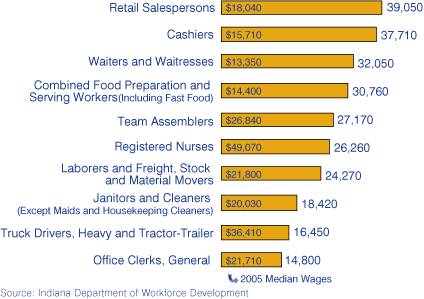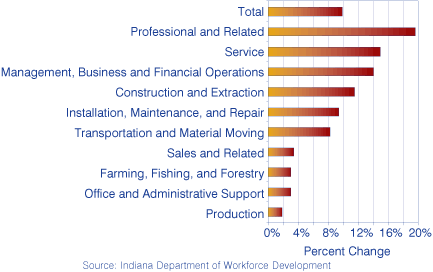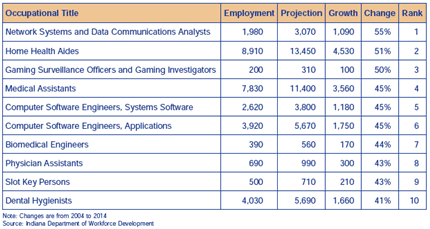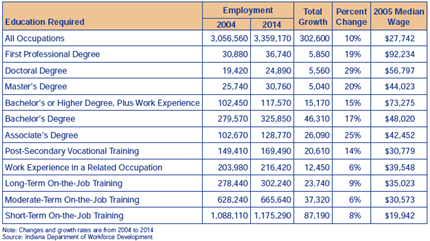Indiana's Occupational Employment Outlook to 2014
Indiana's employment is expected to grow by 302,600 jobs between 2004 and 2014, according to the latest projections from Indiana's Department of Workforce Development. This is a growth rate of 10 percent with employment increasing from 3,056,560 in 2004 to 3,359,170 by 2014. Another 742,160 job openings are anticipated to replace retirees and others departing from the workforce. The 10 occupations projected to have the most job openings are highlighted in Figure 1.
Figure 1: Top Ten Occupations with the Highest Projected Job Openings, 2004 to 2014

The large number of total openings for retail salespersons, cashiers, waiters and waitresses, and combined food preparation and serving workers are due to growth in industries associated with leisure and hospitality, plus the reality that workers move in and out of these jobs quickly—creating openings via replacements. Large growth and openings for registered nurses are due to the increasing demand for health care services and an aging out of this population's workforce. It is no surprise that Indiana will see high growth in most health and service sector occupations, as it will follow the national trend of increasing health care needs as our population ages.
Occupational Groups
The ten fastest growing major occupational groups make up 78 percent of the total growth for the state (see Figure 2).
- Professional and related occupations (19.6 percent growth)
- Service occupations (14.9 percent growth)
- Management, business and financial operations occupations (14 percent growth)
- Construction and extraction occupations (11.5 percent growth).
Figure 2: Ten Projected Fastest Growing Occupational Groups, 2004 to 2014

Indiana has had many recent events that will bring jobs. The news of Honda deciding to locate in Greensburg, Toyota building automobiles at Subaru in Lafayette, a new Nestlé plant in Anderson and American Commercial Lines in Jeffersonville are a few examples of such events. Indiana's Major Moves initiative will provide careers in the construction industry that require a variety of skills and educational experience. Growth in construction and extraction occupations will exceed the state's overall average. However, the employment brought about by Major Moves and other economic development initiatives will not be limited to construction. Production occupations are projected to increase by nearly 2 percent. This occupational group has declined and is expected to continue declining nationally, which makes the projected turnaround in Indiana quite notable.
Detailed Occupations
Indiana's “fastest growing” list largely mirrors the national list, with the exception of the gaming occupations and biomedical engineers. While biomedical engineering is a fast growing occupation nationally, this occupation is growing even faster in Indiana (44 percent versus the national 31 percent). Indiana has aggressively pursued industries in the life sciences industries and already had a solid base in this area. Table 1 displays the 10 fastest growing occupations that had an employment level of at least 100 in 2004. Six of the 10 occupations are a part of the professional group, and the remaining four occupations are all from the services group.
Table 1: Fastest Growing Occupations with Employment of at Least 100 in 2004
Education and Wages
Indiana's occupational projections include a display of occupations along with the most common educational attainment required and the median wages earned for each occupation. It is clear that most of the fastest growing occupations require greater education and are the highest paying jobs (see Table 2). All of the educational attainment groups requiring a degree have a median annual wage of more than $42,000, and jobs are expected to grow at double-digit rates. All jobs that require no post-secondary education are expected to grow at a rate below 10 percent. Occupations requiring only short-term on-the-job training pay a median wage of $19,942—less than half of any of the educational attainment groups requiring a degree. Once again, it appears that education pays and provides the greatest opportunities.
Table 2: Projections by Education Required for Indiana's Occupations, 2004 to 2014
The exception would seem to be in occupations that require a master's degree, as the median wage for that group of occupations is less than those requiring a bachelor's degree. However, over a third of those occupations are in community and social services occupations, such as clergy and rehabilitation counselors—low-paying occupations despite the high level of education required. Were these occupations removed from the group, the median wage expectation for a master's would exceed $51,000.
Notes
- Replacements and Total Job Openings: Demand for workers is driven by two components of total job openings: job growth and replacements of workers who leave their jobs. Those leaving their jobs enter other occupations, retire or leave the labor force for other reasons. Openings that result from replacement needs typically exceed openings resulting from employment growth. Measuring replacement needs is complicated because of the continuous movement of workers into and out of occupations. The replacement needs in the projections process are based on the net change in employment (entrants minus separations) in each age cohort over the projection period. Although this measure understates the total job openings in an occupation, it best represents the job openings for new labor force entrants in that occupation. All references to replacement needs in this article are these net replacements rather than total replacements.
- Online Access: The complete 2004–2014 occupational projections for Indiana are available at www.hoosierdata.in.gov. The projections include data for each detailed occupation within its major group and by educational requirements. Also included are tables with hourly and annual wages and rankings according to growth percentage, numeric growth and total job openings due to growth and replacement needs.
- Source: All projections data produced by the Research and Analysis Department, Advanced Economic and Market Analysis Group, Indiana Department of Workforce Development.
Jon Wright and Bob Ferguson, Research and Analysis
Department
Advanced Economic and Market Analysis Group, Indiana Department of Workforce
Development


